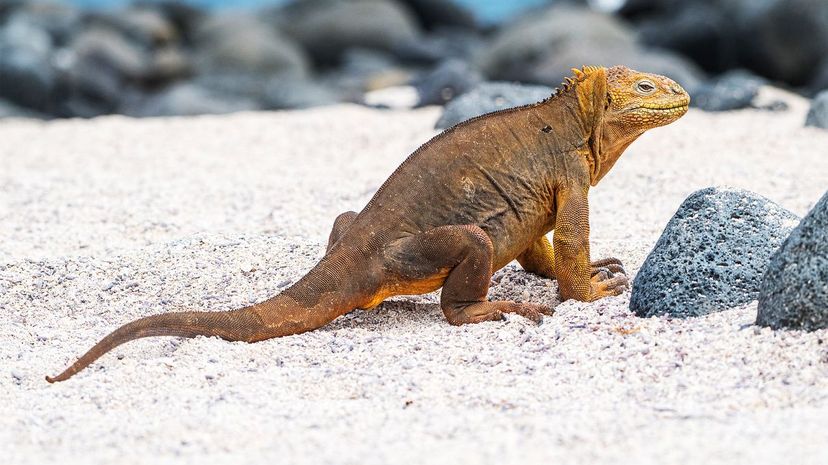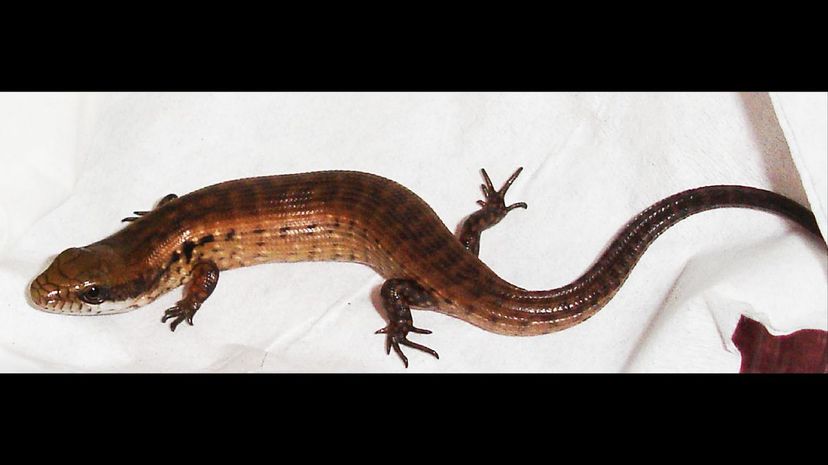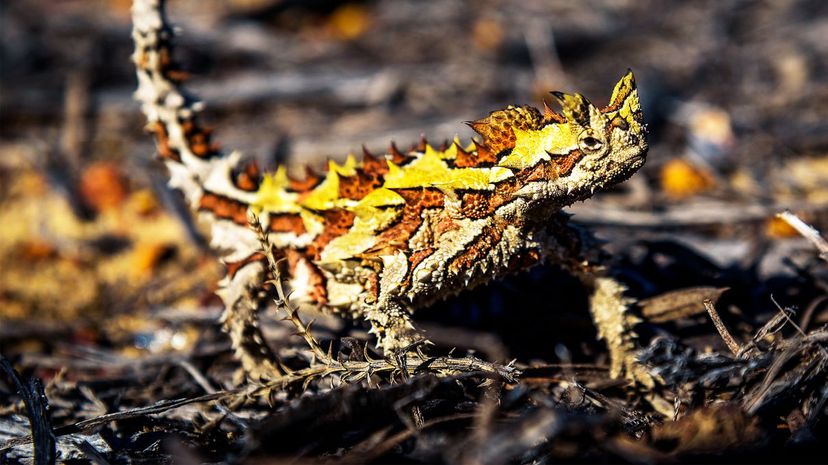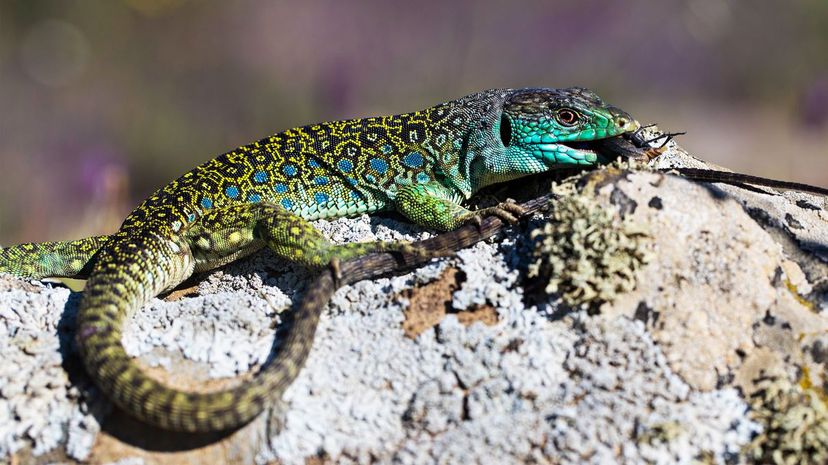
About This Quiz
It's mind-blowing to think that there are species of lizards on Earth right now, just basking in the sun on a rock somewhere, that have barely changed at all in millions of years.
Lizards are just a hearty group of little beasts that seem to be able to endure a lot and keep on keeping on. They're also incredibly cool. From the tiniest little gecko you can keep as a pet in a tank in your house where it might eat a cricket a day, to the massive and terrifying Komodo dragon which can take down man-sized prey, there's a wicked diversity in the world of lizards.Â
It's hard not to be fascinated by these throwbacks to prehistoric times. They're like a living reminder of a history we can never truly know, of what the world might have looked like long before humans ever showed up. That's a pretty cool thing, and it deserves a little respect and recognition.
Speaking of recognition, now's your time to shine by showing us how many species of lizards you recognize. There are many of them in the world. Do you think you can pick out 40 of them? Let's find out!

No animal has a more hardcore name than the satanic leaf-tailed gecko. It also doesn't really deserve the name since it's not particularly evil in any way. Luckily they also go by the names "eyelash leaf-tailed gecko" and "phantastic leaf-tailed gecko" so it's not all doom and gloom.

The plumed basilisk of Central America is a unique animal in appearance and behavior. The plume from the name is very noticeable and gives the lizard a dinosaur-like appearance. Using its tail to stay upright, it can run for a little while on the surface of the water if it falls, no worries because it's an excellent swimmer as well.

The largest Nile monitor on record managed to crack 8 feet, making these enormous lizards indeed. Adult males can be very aggressive, which, combined with their size, makes them dangerous to be around. They are native to Africa, but populations do exist in places like Florida now as well.
Advertisement

Marine iguanas are unique among lizards thanks to the fact they are marine reptiles and the only lizard that forages in the sea. They eat algae in their native habitat, and no one has ever successfully bred or kept them away from the Galapagos Islands.

The green anole is a very popular lizard to keep as a pet and is sometimes called an American chameleon because it can change from bright green to a somewhat muted brown color to blend into its surroundings.

Veiled chameleons are popular lizards to keep in captivity since they're pretty easy to handle, relatively speaking. That has led to a number of them being released into the wild. This, in turn, has led to the population of invasive chameleons you can find in Hawaii right now.
Advertisement

Red tegus are very popular pets as far as lizards go because, if you have space and the ability to care for a massive lizard, they behave quite a bit like dogs. They'll follow their owners around the house, eat and drink from pet bowls and can even be clicker trained.

Australian water dragons are, as the name suggests, very well adapted to the water. They can swim submerged and stay underneath the water for about an hour and a half if necessary. When fleeing from predators, if no water is available, they can also race up a tree and hide in the foliage pretty well.

Bearded dragons are arguably the world's most popular species of lizard to keep as a pet. Compared to most other species, they're very easy to care for and also tend to be more active and whimsical than many species which are more inclined to sit around basking all day.
Advertisement

Blue-tongued skinks are native to Australia but are also reasonably popular as house pets. Because they have such thick bodies and tend to move slowly, they're easy to handle and are well adapted to being kept as pets. They also rarely show off that blue tongue, so getting bitten by one is often not an issue.

Burton's legless lizard is sometimes called a snake-lizard, but it's not a snake. It does have tiny, rudimentary hind legs, but they're little more than stumps. These lizards tend to feed on other lizards in the wild and, sometimes, snakes.

Caiman lizards are water-loving lizards native to South America. They're good swimmers and tend to live in marshy or swampy areas. They also grow to be about 4 feet in length and eat almost nothing but snails.
Advertisement

Chuckwallas are pretty chill lizards overall, sustaining themselves on a diet of plants and running for cover at any sign of danger. Their self-defense strategy involves wedging themselves in a crack between rocks and then inflating themselves with air so they can't be pulled out.

Crested geckos were all but gone from the world in the 1990s and are now one of the most popular species to keep as house pets. They come in a wide variety of colors which has encouraged breeders to try to produce lines with specific colors and patterns that can sell for more money.

The Egyptian uromastyx is obviously found throughout Egypt and other parts of North Africa and the Middle East. They were hunted for food and leather since they can grow to be a fairly substantial size and are not remarkably aggressive.
Advertisement

Flying geckos, like most flying animals that don't have wings, have adapted flaps of skin that allow them to glide between trees. Their flesh is highly camouflaged, and if they have their eyes closed, they become nearly indistinguishable from the trees in which they live.

Fire skinks get their name from the vivid scale coloration on their bodies. They usually have a more gold or brown on their backs, but their bellies will be bright orange and red which makes them stand out in a crowd.

Frilled lizards are some of the most easily recognizable lizards in the world thanks to that dramatic frill that pops up when they're challenged or frightened. The dilophosaurus from "Jurassic Park" is a frill, and word has it that demand for real frilled lizards increased after the movie.
Advertisement

Galapagos land iguanas live across several of the Galapagos Islands but nowhere else in the world as they do not take to captivity at all. They're mostly herbivores, though some have been observed eating insects. They get most of the water in their diet from cactus pears.

While it's rare for a lizard to be venomous, the Gila monster's bite will inject venom into a victim, and it's incredibly painful. Despite that, some people still keep these lizards as pets because of their bright color pattern.

The giant Hispaniola galliwasp is native to the island of Hispaniola and can be found in Haiti and the Dominican Republic. "Giant" is a relative term here since they only grow to be about 12 inches in length. A baby is shown here.
Advertisement

Jackson's chameleon is one of the easiest to identify lizards in the world thanks to the three horns on its head that make it look like a little triceratops. Because they are so widely coveted as pets, a number of specimens have been let loose in non-native habitats, and populations are springing up across the United States.

Gargoyle geckos get their unusual name from the little bumps they have on their head. Those bumps resemble horns and sure, some other lizards actually have horns, but they still call these guys gargoyles because of it.

No one on Earth would ever keep a Komodo dragon as a pet and for good reasons. These lizards reach lengths of up to 10 feet, and their toxic bites could very well kill a human if left untreated. The claws of a Komodo dragon can rip cages apart. Komodo dragons are fun to see at a zoo, but it's probably never a good idea to get close to one.
Advertisement

Moloch is the name of a Canaanite god from the Bible who later became associated with demons, so this poor lizard has a bad reputation from the start. Its intimidating names likely come from the fact it's covered from head to toe in an array of very sharp-looking spikes that it uses for self-defense.

Monkey-tailed skinks live on the Solomon Islands and can grow to nearly 3 feet in length. Its name refers to the fact it has a prehensile tail that it can use when moving through the trees to help keep it balanced.

Both names for this lizard, pircklenape and mountain horned dragon, refer to the row of spikes that run down the lizard's back. The mountain part just refers to the fact they really like living in the mountains.
Advertisement

Along with the Gila monster, the Mexican beaded lizard is the only other venomous lizard in North America. Bites are very rare and likely not fatal, but they will be very painful. Only eight bites have been reported in the last 100 years.

The Northern alligator lizard sounds a little more intimidating than it really is. At about 6 inches in length, they're much less fearsome than actual gators, but they get the name from their scales which make them resemble tiny alligators.

Sungazers live in Africa and grow to be about a foot long to the tip of the tail. Their association with dragons is pretty ingrained these days thanks to their spiky, horn-like scales and the fact scientists reclassified them in 2011 and added them to a brand new genus called Smaug, after the dragon in "The Hobbit."
Advertisement

Texas horned lizards live throughout the Southern U.S. and into Mexico. They're actually members of the iguana family and as cool as they look, they're extremely hard to keep as pets because their diet is monstrous. One of these little lizards can eat a few thousand ants per day, much more than the average pet owner can supply.

Tokay geckos are native to various parts of Asia and are known for their frog-like croak. Some people say it sounds like the gecko is saying "tokay" but it's also described as something like "geck geck" and "poo-kay." Soldiers in Vietnam also gave it a rather vulgar nickname that you can Google if you want.

Tuataras look like lizards but evolved along a separate but similar path. They're a little more prehistoric than your average lizard and likely have been around for 200 million years or so. They also tolerate much colder weather than most lizards, and they are comfortable in temperatures in the mid-60s and even high 50s.
Advertisement

Savannah monitors are native to Africa, though there is a relatively prominent illegal trade in the lizards. Animal rescues that deal with lizards often get them, since people who take them in as pets abandon them when they aren't prepared to care for the lizards once they reach 3 feet in length!

Cuban rock iguanas are some of the largest iguanas in the world and as the name suggests, can be found on the rocky coasts of Cuba. A feral colony lives on Isla Magueyes near Puerto Rico. They were released from a zoo in 1950 and have thrived ever since.

The Eastern fence lizard is found throughout the Eastern United States and gets its name from the fact that you can very often find them basking in the sun on top of fence posts. They're usually gray or brown, and that helps them blend into their surroundings, which is helpful when you're on top of a fence all day.
Advertisement

The Dumeril's monitor can be found in Southeast Asia where it can grow to upwards of 4 feet in length. Generally speaking, you don't want to run afoul of one of these lizards, and keeping one as a pet can be tricky since they spend much of their time in aquatic environments.

Frog-eyed geckos are sometimes called wonder geckos which is a must cooler sounding name, all things being equal. When attacked, the gecko will let loose a squeaking sound and may rear up on its hind legs and open its jaws in a display of intimidation.

The jeweled lacerta, or ocellated lizard, is native to Europe and is typically not a fan of human interaction. They're fast little things and will be quick to run for cover if they sense danger. They can be kept in captivity but probably should be left to those who have a little more experience with lizards since they can be a bit difficult.
Advertisement

Leopard geckos are one of the most popular lizard pets in North America thanks to their unique appearance and the fact they're relatively easy to care for. Breeders have already begun breeding them for specific color and pattern characteristics which can bring in a lot of money if people are looking for a designer type of pet.